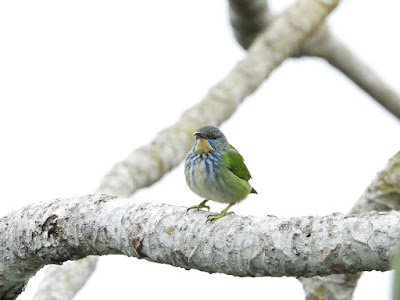We were half way through our trip and heading west, back along the Pan-American Highway. Back towards Panama City and on to the
Canopy Family's next property, the
Canopy Tower where Carlos is Head Guide. We made a couple of stops en route to get some drone shots of the van travelling along the highway and once more at Avicar aka 'The Hummingbird Cafe'.
After five hours, we finally arrive. The Tower is an old disused US military radar tower overlooking the Panama Canal. Built in the 1960's it was turned into a unique eco-lodge in 1997 and is situated in the stunning Soberania National Park.
The colour scheme (turquoise blue, maroon, yellow) is special too. The designer who came up with the colour scheme based it on the colours found on one of the local residents, the Keel-billed Toucan!
 |
| The Canopy Tower - a birder's dream |
 |
The colours inside and out are all found
on the Keel-billed Toucan. |
From the top of the Tower you are at eye level with the trees giving incredible views of birds and mammals as you would never normally see them. Below the viewing deck is a comfy relaxation area and the restaurant, below that, the rooms, it's just incredible. A few birds before breakfast...
 |
Bay-breasted Warblers are by far the most
frequently seen warbler at the Tower. |
 |
| Another one, they were moving through all the time. |
 |
| Wouldn't mind seeing one of these in the UK |
 |
| Cinnamon Becard |
 |
| Scarlet Tanager, male in winter attire. |
 |
| Shining Honeycreeper, female |
 |
| Shining Honeycreeper, female |
 |
| Tennessee Warbler |
Our goal on this day was to head out along the Pipeline road. The Pipeline Road was constructed by the US army during the 1960's as a fuel pipeline but was never used. Nowadays the original construction track that runs alongside the pipeline, extends for 17 km into Soberania National Park and is one of the best birding spots in Panama.
The sharp ears of Carlos Bethancourt soon located our target filming bird, the Red-capped Manakin...
 |
| Red-capped Manakin, male |
These stunning birds have the most incredible dance to attract the attention of females. Likened to the moonwalk, this one attracted two female Red-capped and a Blue-capped Manakin. He was also joined on the 'dance branch' by a juvenile male, which looks exactly like a female except for its yellowish thighs.
The scene was soon upset though, the birds vanished but then Carlos discovered why - he'd found a Slaty-backed Forest Falcon sitting a few meters further back in the jungle.
 |
Slaty-backed Forest Falcon
Rarest of the forest falcons in Panama |
After getting the footage we needed, we moved on to our next filming subject, army ants! Army ants are quite common along the pipeline road and the quickest, easiest way to locate them is to keep your ears open for their followers, antbirds.
We soon found exactly what we had been looking for and with the ants, came the birds.
 |
| Spotted Antbird - definitely my favourite, so smart! |
 |
| Spotted Antbird, male |
 |
| Spotted Antbird, male |
Antbirds don't actually eat the ants but rather the insects that move away from the army ant swarm. As such, they stay low and very close to the swarm and often in good numbers. The ant swarm we were filming was being trailed by 2-3 Bi-coloured Antbirds, a pair of Spotted Antbirds and at least two Ocellated Antbirds with their stunning blue facial skin.
 |
| Ocellated Antbird |
 |
| Ocellated Antbird |
 |
| Ocellated Antbird |
Antbirds weren't the only birds following the swarm though. Greay-headed Tanagers were also taking advantage of the feast along with Plain Brown and Northern Barred Woodcreepers.
 |
| Grey-headed Tanager |
 |
| Plain-brown Woodcreeper |
Filming over for the morning, it was back to Canopy Tower to pack and prep to move to our next location, the Canopy Lodge.


























































